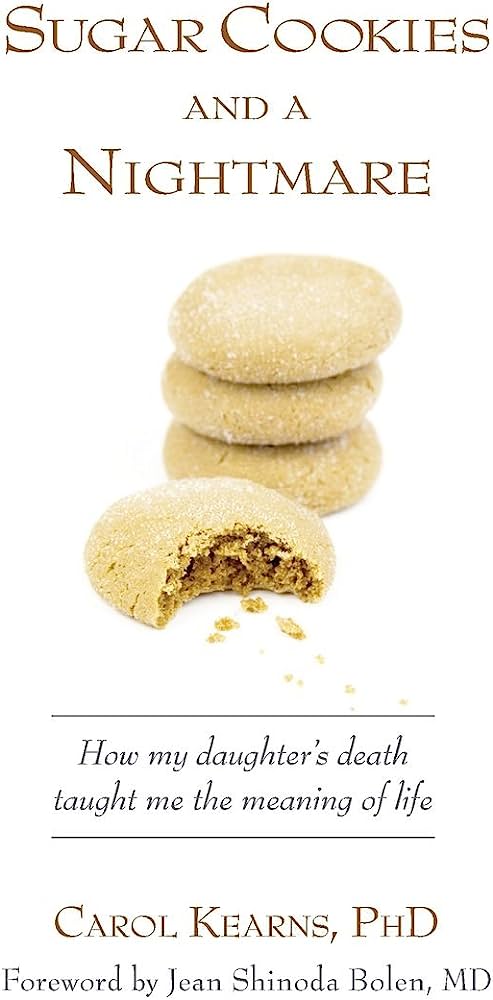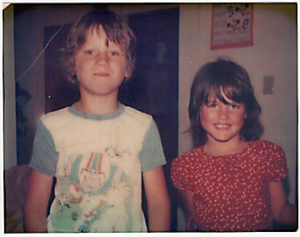 When Carol Kearns lost her 7-year-old daughter Kristen to a rogue wave in 1976, she thought her life had come to an end. Lost in a haze of grief and despair, she spent the next 10 days praying for a miracle that never came. Krissie’s remains were eventually recovered, but so little was left of her body that Kearns never got her one and only wish…to see and hold her little girl again.
When Carol Kearns lost her 7-year-old daughter Kristen to a rogue wave in 1976, she thought her life had come to an end. Lost in a haze of grief and despair, she spent the next 10 days praying for a miracle that never came. Krissie’s remains were eventually recovered, but so little was left of her body that Kearns never got her one and only wish…to see and hold her little girl again.
Thus began a journey of 30 years, which Kearns recounts in “Sugar Cookies and a Nighmare” through a series of letters to Krissie, her older brother Michel, and the woman she describes as her savior, the pioneering grief researcher Elizabeth Kubler-Ross. Both heartbreaking and inspiring, the letters tell the story of a woman struggling to come to grips with the unthinkable while also trying to support her grieving son. (Michel was caught in the same wave that dragged Kristen out to sea.) But Kearns soon realizes that she cannot help herself or Michel unless she faces the raging emotions that Krissie’s death left in its wake. Reluctantly, she sends Michel to live with her ex-husband and his wife. She then joins Kubler-Ross at Shanti Nilaya (Sanskrit for “ultimate home of peace.”). There, she begins the gut-wrenching process of “working through” her grief.
“Sugar Cookies and a Nightmare” is a short book, just 178 pages long. Nevertheless, it is a revealing and instructive glimpse into the complexities of grief and loss. It begins with an open letter to an unnamed “Doctor Expert” who Kearns (now a clinical psychologist specializing in grief and loss) hears counseling a woman on a radio talk show. The woman wants to know if it is acceptable to acknowledge the birthday of a friend’s daughter who recently died. The grief “expert” answers with an emphatic, “No!” adding that the grieving mother needs to “move on” with her life.

Kristen with Michel shortly before her death
Credit: carolkearns.com
For the next 25 pages, Kearns explains to “Doctor Expert” how wrong her advice is. She points out again and again how important it is for friends, family and coworkers to acknowledge the fact that a child who has died is still very much “alive” in their family’s thoughts and memories. Later in the book, she talks about how she and Michel and her now-husband Bob still celebrate Krissie’s birthday and honor her on the date of her death. To do anything less would be unthinkable, she explains.
Kearns’ writing style is forthright and engaging. Throughout the book, we get the sense of a woman who has traveled through the worst pain imaginable and come out the other side. She has done the gut-wrenching work that she now asks her clients to do. And though her pain still returns, it is less intense and more short-lived. She is, in her own words, “happy” again. For anyone dealing with the early stages of grief, I’m sure that is a comforting thought.

Carol Kearns in San Francisco in 2009
Credit: twitter.com
Overall, “Sugar Cookies and a Nightmare” is a compelling look at grief and loss. In some places, it swerves off into the realm of the paranormal, which may put some readers off. For example, early in the book, Kearns recounts her unexplained reluctance to take the trip to the Oregon coast during which Krissie lost her life. And later she makes reference to a series of pictures Krissie drew that both she and Kubler-Ross believed show Krissie’s prescient knowledge of her upcoming death.
Kearns also recounts the experiences of several clients who had dreams or fears about the death of a loved one that later came true, or experiences that they interpreted as communication from the person who had died. Some readers may find this comforting; others may find it odd. But Kearns puts it into perspective when she explains that these experiences — whether truly paranormal or just ordinary coincidence — seem to play an important part in helping the bereaved make sense of inexplicable events.
Carol Kearns wrote “Sugar Cookies and a Nightmare” more than a decade ago, and since then many other authors have tackled the subject of grief. And new theories about how we process grief have replaced Kubler-Ross’s groundbreaking “five stages” work. Nonetheless, Kearns succeeds in conveying some important lessons, most notably that grief is not something we “get over,” and that working through the pain takes a great deal of hard work. This alone makes it a worthwhile read.
Note: Read SevenPonds’ 2015 interview with Carol Kearns here.

 “Sugar Cookies and a Nightmare” by Carol Kearns, Ph.D.
“Sugar Cookies and a Nightmare” by Carol Kearns, Ph.D.


 Our Monthly Tip: Make an “In Case of Death” File to Ease Loved One’s Grief
Our Monthly Tip: Make an “In Case of Death” File to Ease Loved One’s Grief
 Passing of Beloved Comedian Births a New Comedy Festival
Passing of Beloved Comedian Births a New Comedy Festival















